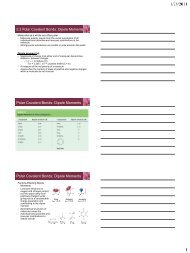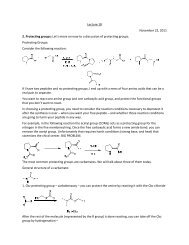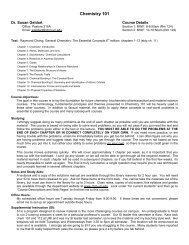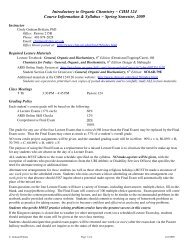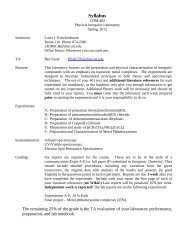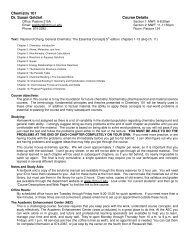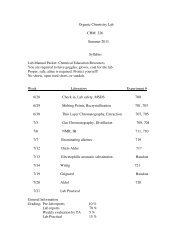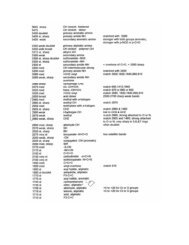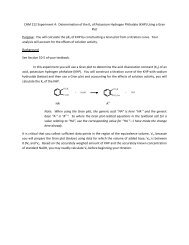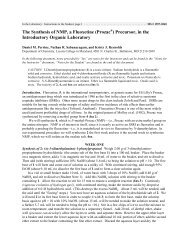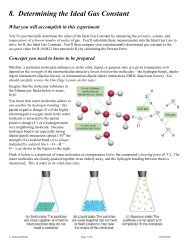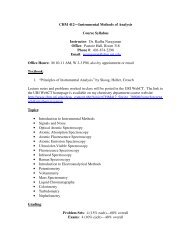Concepts you need to know to be preparedA compound’s chemical formula is made up <strong>of</strong> the symbols (from the Periodic Table) that represent each <strong>of</strong> theelements in that compound. And the numerical subscripts following these symbols indicate the fixed proportion inwhich the elements combine when that compound is formed by a chemical reaction.For an ionic compound (such as sodium chloride, NaCl), youshould NEVER think <strong>of</strong> that compound as just a PAIR <strong>of</strong>oppositely-charged ions, as the chemical formula seems to imply.If you look closely at the illustration <strong>of</strong> a sodium chloride (NaCl)salt crystal to the right, you’ll see that it is definitely NOT just apair <strong>of</strong> Na + and Cl - ions, but an extensive, orderly, threedimensionalnetwork <strong>of</strong> charged particles.Each Na + ion is attracted to the Cl - ions immediately above,below, to the right, to the left, in front, and behind it. And eachCl - ion is attracted to the Na + ions surrounding it.So it’s important to realize that the chemical formula for ANYionic compound does NOT describe a small grouping <strong>of</strong> ions, itdescribes the fixed proportion in which vast numbers <strong>of</strong> theoppositely-charged ions combine in order to appropriatelybalance out the positive and negative charges.So – one way to think about the chemical formula for Copper (II) Chloride, CuCl 2 , the ionic compound in thisweek’s experiment, is that it expresses the “ION ratio” <strong>of</strong> the elements in the compound:The compound CuCl 2 contains 2 Cl - IONS for every 1 Cu 2+ ION.But a “bigger picture” way to think about that chemical formula is that it expresses the “MOLE ratio” <strong>of</strong> theelements in the compound:The compound CuCl 2 contains 2 MOLES <strong>of</strong> Cl - ions for every 1 MOLE <strong>of</strong> Cu 2+ ions.One mole <strong>of</strong> any pure substance (element or compound) is really just an Avogadro’s number <strong>of</strong> “particles” <strong>of</strong> thatsubstance (where “particles” = atoms, ions, or molecules). For example:Or in the case <strong>of</strong> Copper (II) ions:1 mole <strong>of</strong> Copper metal = 6.02 x 10 23 Cu atoms1 mole <strong>of</strong> Copper (II) ions = 6.02 x 10 23 Cu 2+ ionsAn Avogadro’s number <strong>of</strong> atoms for a particular element, one MOLE <strong>of</strong> the element, will ALWAYS have a mass inGRAMS equal to the Atomic Weight listed for that element on the Periodic Table:Or for Copper (II) ions:1 mole <strong>of</strong> Copper (Cu) = 6.02 x 10 23 atoms <strong>of</strong> copper = 63.55 grams <strong>of</strong> Copper metal1 mole <strong>of</strong> Copper (II) ions = 6.02 x 10 23 Cu 2+ ions = 63.55 grams <strong>of</strong> Copper (II) ionsNOTE: The mass in grams <strong>of</strong> 1 mole <strong>of</strong> any pure substance is commonly referred to as the “Molar Mass.”A similar unit relationship is easily determined for any other element on the Periodic Table. The first part <strong>of</strong> thisunit relationship is always the same:1 mole <strong>of</strong> any element = 6.02 x 10 23 atoms <strong>of</strong> that elementC. Graham Brittain Page 2 <strong>of</strong> 9 9/28/2010
Péter Orsolya: »Feminae improbissimae« 79A fenti klasszikus kori szöveg azért figyelemre méltó, mert a jogtudós nem operálazzal az ismert közhellyel, hogy a nők „könnyelmű természetük” 7 vagy a női nem„veleszületett gyengesége” 8 miatt eleve alkalmatlanok bizonyos feladatok betölté-7 A híres szöveghelyen (Inst. 1.144.) Gaius a veteres, a préklasszikus kor jogtudósainak véleményét idézia serdült nők felett fennálló gyámság indokolásával kapcsolatban: „Veteres enim voluerunt feminas,etiamsi perfectae aetatis sint, propter animi levitatem in tutela esse” – „A régiek ugyanis azt akarták,hogy a nők, mégha teljes korúak is, felfogásuk könnyelműsége miatt gyámság alatt legyenek.” Gaiusinstitúciói. Fordította Brósz Róbert, Budapest, Nemzeti Tankönyvkiadó, 1996.8 A nők veleszületett gyengeségét és bizonyos feladatokra való alkalmatlanságát a római szöveghelyekaz infirmitas sexus, esetleg az imbecillitas sexus szófordulatokkal írják le – amely azonban, mindennegatív felhangja ellenére, a nők számára bizonyos esetekben kedvezőbb jogi helyzetet is eredményezhetett.Így például a D. 16.2.2. szöveghelyen (Ulpianus libro vicensimo nono ad edictum) a nőkintercessio-ját tiltó Senatusconsultum Velleianum-ra vonatkozó fejtegetést Ulpianus így vezeti be:„Verba itaque senatus consulti excutiamus prius providentia amplissimi ordinis laudata, quia opem tulitmulieribus propter sexus inbecillitatem multis huiuscemodi casibus suppositis atque obiectis” – vizsgáljukmeg tehát ennek a senatusconsultumnak a szavait, de csak azt követően, hogy megdicsértük e kiválótestület előrelátását, mely nemük gyengesége (sexus imbecillitas) indokán számos feltételezett éstényleges esetben segítséget nyújtott a nőknek. A D. 22.6.9. pr. (Paulus libro singulari de iuris et factiignorantia) jogbeli és ténybeli tévedéssel foglalkozó szöveghelyén Paulus a jogban való tévedésről értekezik,és megállapítja, hogy „Regula est iuris quidem ignorantiam cuique nocere, facti veroignorantiam non nocere. Videamus igitur, in quibus speciebus locum habere possit, ante praemissoquod minoribus viginti quinque annis ius ignorare permissum est. Quod et in feminis in quibusdamcausis propter sexus infirmitatem dicitur: et ideo sicubi non est delictum, sed iuris ignorantia, nonlaeduntur.” – az a szabály, hogy a jog ismeretének hiánya árt, a tények ismeretének hiánya pedignem árt. Ezért lássuk, hogy a fenti szabálynak milyen esetekben lehet helye, elsőként előrebocsátva,hogy a 25 évnél fiatalabbaknak megengedik, hogy ne ismerjék a jogot, és bizonyos esetekben ugyaneza helyzet a nőkkel, nemük gyengesége miatt („propter sexus infirmitatem”): így mindaddig, amígnem bűncselekményt követnek el, hanem a jog ismeretének hiányáról van szó, jogaik nem sérülnek. ACodex egyik, Kr. u. 530-ban kiadott császári konstitúciója szerint (C. 4.29.22. Iustinianus) ha egynagykorú nő elzálogosít valamit vagy más biztosítékot ad, majd két év elteltével ugyanabban az ügybenmég egyszer biztosítékot ad, a császár rendelkezése szerint a második biztosítékadás nem érvényes,hiszen a nő gyengesége miatt („ex consequentia suae fragilitatis”) tette ki magát másodszor isveszteségnek. Az infirmitas/imbecillitas sexus megítélésével kapcsolatosan ld. Siro Solazzi: Infirmitasaetatis e infirmitas sexus, Archivio Giuridico 45, 1930, 3-31. old. = Scritti di diritto romano III., Napoli,Jovene, 1960, 357-367.old.; Adolf Berger: Encyclopedic Dictionary <strong>of</strong> Roman Law, Philadelphia, TheAmerican Philosophical Society, 1953 (Transactions <strong>of</strong> the American Philosophical Society, New Series43 (1953) 2),”infirmitas sexus” címszó alatt; Suzanne Dixon: Infirmitas sexus: Womanly Weakness inRoman Law, Tijdschrift voor Rechtsgeschiedenis 52 (1984) 4., 343-371.o.; Renato Quadrato:Infirmitas sexus e levitas animi: il sesso ”debole” nel linguaggio dei giuristi romani, in: Scientia iurislinguaggio nel sistema giuridico romano (szerk. Francesco Sini, Rosanna Ortu) Torino, Giappichelli,2002, 155-194. o. A nők veleszületett gyengeségének toposza a római kort követően gyakorlatilag aXX. század elejéig tartotta magát; ezzel kapcsolatosan ld. Marina Graziosi: Infirmitas sexus. La donnanell'immaginario penalistico, Democrazia e diritto, 2 (1993), 99-143.o. A fentiekkel kapcsolatosan akaratlanulis bizarr bizonyítékot szolgáltat a Women in the World's Legal Pr<strong>of</strong>essions (szerk. UlrikeSchultz, Gisela Shaw, Hart Publishing, Oxford, 2003.) című tanulmánykötet, melyben a világ különbözőországaiból származó szerzők mutatják be a nők által hazájukon belül az igazságszolgáltatásban betöltöttszerepeket. Az olaszországi helyzetet bemutató tanulmány (Pr<strong>of</strong>essional Body and GenderDifference in Court: the Case <strong>of</strong> the First (Failed) Woman Lawyer in Modern Italy, 419-435. o.) LidiaPoet esetével foglalkozik, akit 1883-ban nagy vita után hivatalosan is felvettek a torinói ügyvédi kamarába,de a döntést a helyi bíróságnál szinte azonnal megtámadták és elérték a jogot végzett asszonykamarából történő kizárását, majd a legmagasabb szintű fórumként eljáró Semmítőszék helybenhagytaaz alsóbb fokú bíróság döntését. Lidia Poet története mellett a szerző más, ugyanilyen sorsra jutott,jogvégzett nők élettörténetét is felidézi, továbbá hivatkozik az infirmitas sexus mélyen gyökeredző



